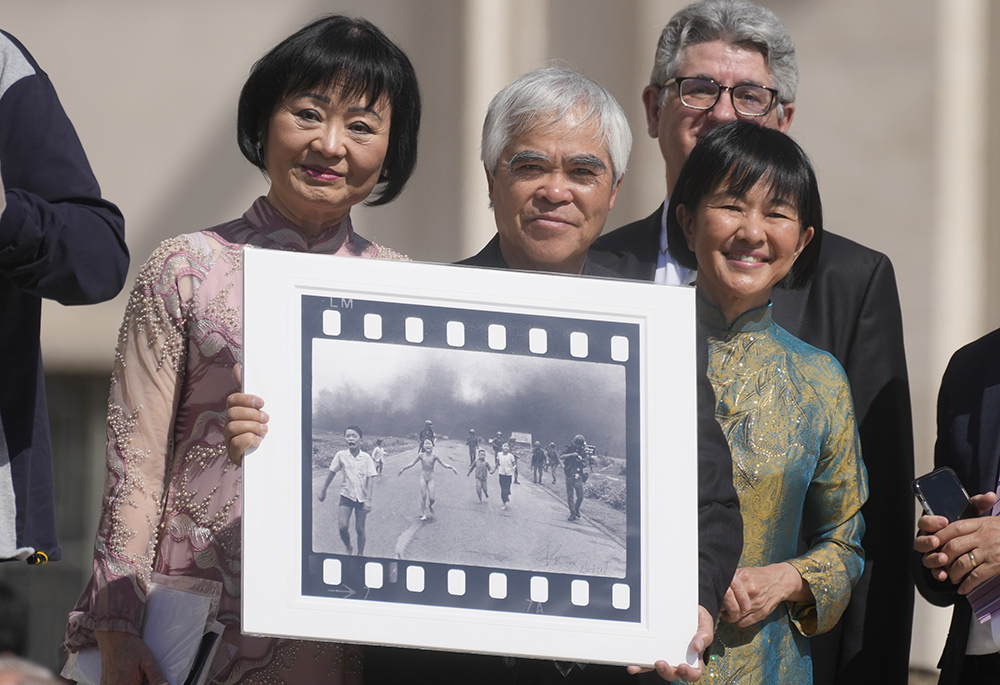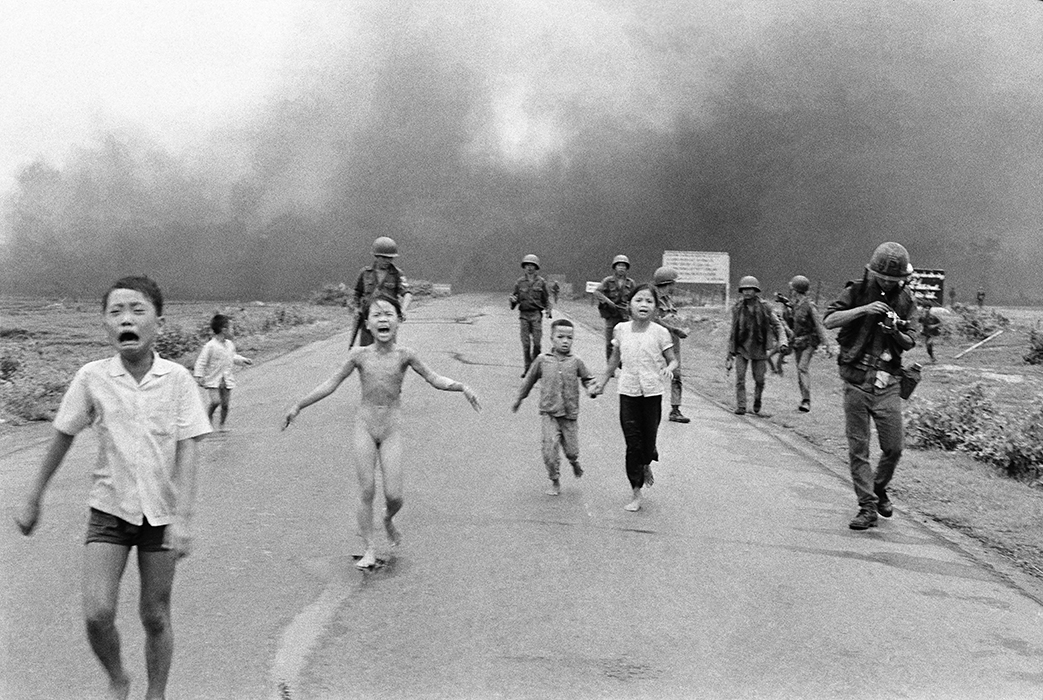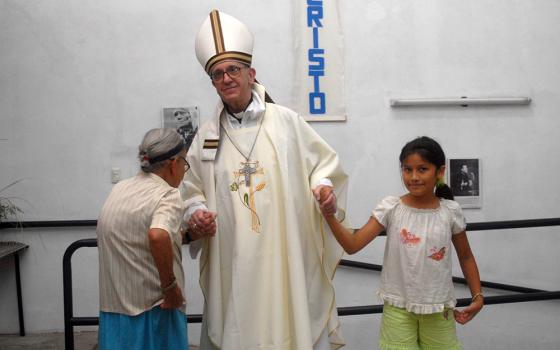
Pulitzer Prize-winning photographer Nick Ut, center, flanked by Kim Phúc, left, holds the "Napalm Girl", his Pulitzer Prize winning photo, as they wait to meet with Pope Francis during the weekly general audience in St. Peter's Square at The Vatican, on May 11, 2022. (AP photo/Gregorio Borgia, file)
A controversial new documentary film claims to have uncovered a scandal behind one of the most iconic wartime photographs of the 20th century.
For more than 50 years, now-retired Associated Press photographer Nick Ut has been credited with the photo, "The Terror of War," also known as "Napalm Girl," which shows a 9-year-old Vietnamese girl screaming and running naked on a South Vietnamese road after being severely burned during a napalm attack on the village of Trang Bang on June 8, 1972.
Set to debut this weekend, "The Stringer" asserts that a little-known Vietnamese freelance photographer was the one behind the lens that day more than a half-century ago. Ut and the Associated Press strongly reject the premise of the film and deny that Ut is not responsible for the famous photograph.
The photo has brought worldwide attention to Ut and Kim Phúc, the subject of "The Terror of War" photo. Ut and Phúc, who is now 61, presented the photo, framed and signed with their signatures, to Pope Francis in May 2022 during a general audience in St. Peter's Square. They were both in Italy at the time to open an exhibit of Ut's photographs in Milan.
Directed by Bao Nguyen and produced by Fiona Turner and Terri Lichstein, the documentary film claims to shed light on "a scandal behind the making of one of the most-recognized photographs of the 20th century." The producers did not respond to National Catholic Reporter's requests to comment for this story.
James Hornstein, an attorney who is representing Ut, told NCR that on Jan. 15 he sent a cease-and-desist letter to the documentary's distributor and to the Sundance Film Festival warning that they would "bear the consequences of the defamation to Nick Ut" if the film is presented.
"All the evidence, every bit of the history, is that this picture was taken by Nick Ut, and there is no credible evidence to the contrary," Hornstein said.

South Vietnamese forces follow after terrified children, including 9-year-old Kim Phúc, center, as they run down Route 1 near Trang Bang after an aerial napalm attack on suspected Viet Cong hiding places, June 8, 1972. A South Vietnamese plane accidentally dropped its flaming napalm on South Vietnamese troops and civilians. The terrified girl had ripped off her burning clothes while fleeing. The children from left to right are: Phan Thanh Tam, younger brother of Kim Phúc, who lost an eye, Phan Thanh Phouc, youngest brother of Kim Phúc, Kim Phúc, and Kim's cousins Ho Van Bon, and Ho Thi Ting. Behind them are soldiers of the Vietnam Army 25th Division. (AP photo/Nick Ut)
"In the absence of new, convincing evidence to the contrary, AP has no reason to believe this photo was taken by anyone other than Ut," the Associated Press said in a separate prepared statement that added that the news agency has been aware of the film "for some time."
In a statement provided by Ut's attorney to NCR, Kim Phúc described claims that Ut did not take the photograph as "mean and untrue." Phúc added that she would "never" participate in the documentary "because I know it is false."
On Jan. 15, the Associated Press released a 22-page report that the agency said was based on its own six-month review of "The Terror of War" photo. The news agency said its investigation supports the historical account that Ut is the photographer responsible for taking the picture.
"All eyewitnesses on that horrific day including my uncle have confirmed through the years that it was Nick Ut who was there, who ran towards me to take the photo and brought me to the closest hospital," said Phúc, who grew up in the Cao Dai religion and converted to Christianity when she was 19.
The Associated Press said it asked the filmmakers to show their full materials without preconditions, but that they did not agree to do so.
"While we have been unable to see the film, we have reviewed the partial information the filmmakers shared with us, along with our archives and publicly available records, and interviewed seven eyewitnesses on the road in Trang Bang and in the bureau the day the photo was taken, along with four others with detailed knowledge of AP's operations in Vietnam and the history of the photo," the Associated Press said.
The documentary premieres at the Sundance Film Festival in Park City, Utah, on Saturday, Jan. 25. The film features interviews and presents evidence gathered over a two-year period to make the case that Ut was wrongfully credited with taking the picture.
Advertisement
The film's explosive allegation that Ut was not the actual photographer of "The Terror of War" appears to rest in part on the statements of Carl Robinson, a former Associated Press photo editor, according to the news agency's Jan. 15 report.
In that report, the Associated Press depicts Robinson as a disgruntled former employee who was dismissed from the agency in 1978. The Associated Press said neither Robinson nor the freelance photographer for decades publicly challenged Ut's credit for the photo. The Associated Press also noted that Robinson did not dispute the photo's origin when he was interviewed for AP Corporate Archives on May 2, 2005.
The Associated Press added: "AP photos also show Robinson holding a bottle of champagne in one hand and drinking from a glass in the other as colleagues apparently toast Ut's Pulitzer win in May, 1973."
Hornstein, the attorney for Ut, accused Robinson of having a "vendetta" against the Associated Press and that he waited until the principal eyewitnesses died before making his claim that he switched the credit to Ut on the orders of Horst Faas, then the Associated Press photo chief in Saigon. Faas died in 2012.
"There is not a single other eyewitness who would corroborate this nonsense and this defamation that Carl Robinson is putting out," Hornstein said.
In interviews and essays he has written over the years, Ut has recounted his story that he took the photograph and then transported Kim Phúc and other children wounded in the attack to a hospital in Saigon.
"I looked in my camera's viewfinder [and] I saw the girl running from black smoke. I say, 'Why isn't she wearing clothes?' And I run and take a lot of pictures of her," Ut told NBC News in 2017 when he retired from the Associated Press after 51 years there.
"At no point over the last half-century has his credit for the famous image been seriously challenged," the Associated Press said in its Jan. 15 report.
In her 2017 autobiography, Fire Road, as well as in interviews and op-eds, Phúc has credited her faith as a born-again Christian with helping her to find forgiveness and peace in her life. Today, Phúc lives in Toronto with her husband.
"I found my purpose in life is to glorify his name. … Even though I suffer a lot of scars and pain, he [healed] my heart. He let me be alive, and he let me learn about how great my God is, and God is love," Phúc told the Christian Broadcoasting Network in 2017.
In an interview with Vatican News in May 2022, Phúc, a UNESCO goodwill ambassador who leads her own foundation that advocates for child victims of war, spoke of her humanitarian efforts over the years. "Half a century later, as a survivor, I allow myself to say that we do not want war, but peace," she said. "Because the world needs peace."






